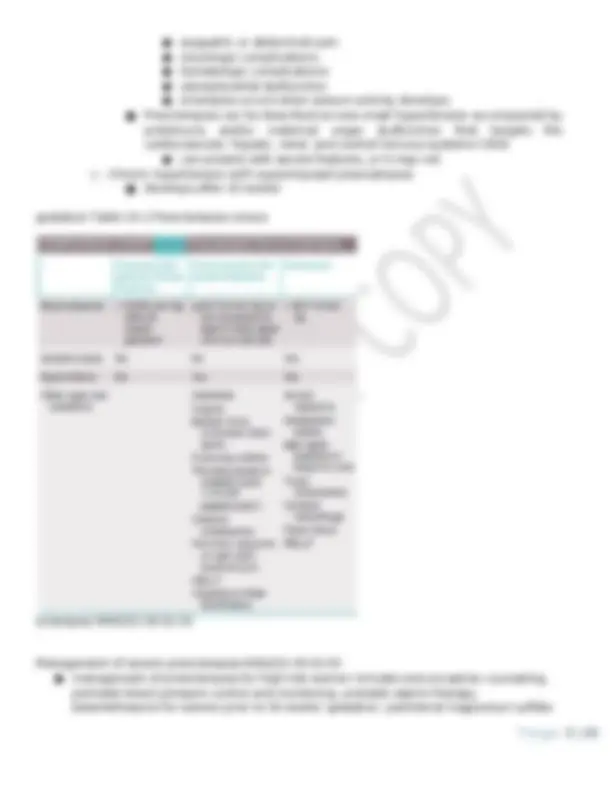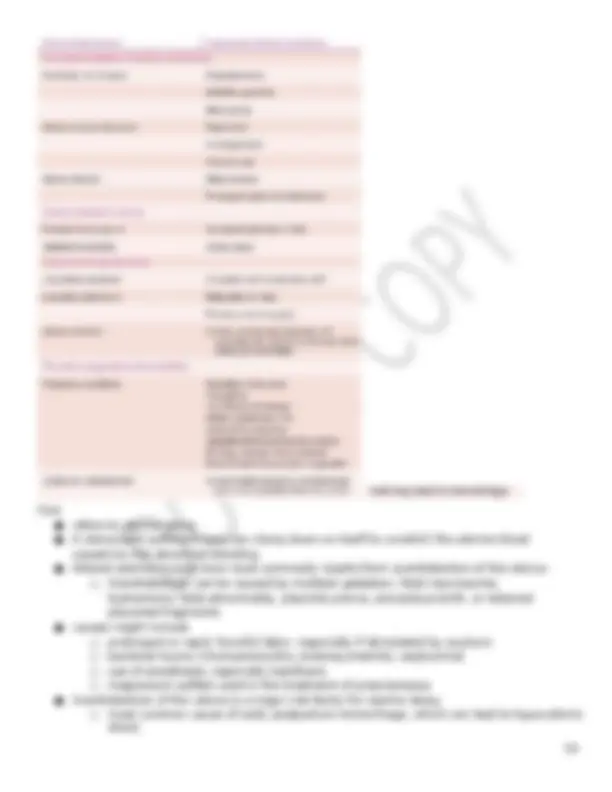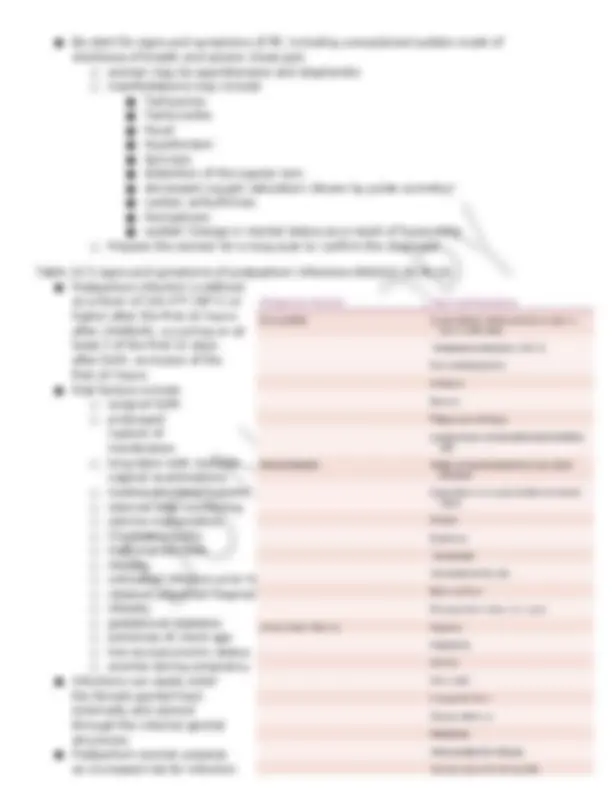













































































Study with the several resources on Docsity

Earn points by helping other students or get them with a premium plan


Prepare for your exams
Study with the several resources on Docsity

Earn points to download
Earn points by helping other students or get them with a premium plan
Community
Ask the community for help and clear up your study doubts
Discover the best universities in your country according to Docsity users
Free resources
Download our free guides on studying techniques, anxiety management strategies, and thesis advice from Docsity tutors
Detailed information on the nursing management of cord prolapse and cesarean birth. It covers the criteria for a safe trial of labor for a woman who has had a previous cesarean birth, the importance of prompt recognition and management of cord prolapse, and the nursing assessment and indications for cesarean birth. The document also discusses the characteristics and nursing care of large-for-gestational-age newborns, as well as the nutritional needs and oxygen administration for preterm infants. The comprehensive coverage of these topics makes this document a valuable resource for nursing students and professionals working in the field of maternal and neonatal care.
Typology: Exams
1 / 83

This page cannot be seen from the preview
Don't miss anything!












































































Spontaneous abortion Nursing Assessment NSG222.06.01. ● When a pregnant woman calls and reports vaginal bleeding, she must be seen as soon as possible by a healthcare professional to determine cause ○ Ask the woman about the color of the vaginal bleeding (bright red is significant) ○ Ask amount ex. frequency in which she is changing her peripads (saturation of 1 peripad hourly is significant) and the passage of any clots or tissue ■ Instruct her to save any tissue or clots passed and bring them with her to the health care facility ● obtain a description of any other signs and symptoms the woman may be experiencing, along with a description of their severity and duration ○ Varying degrees of vaginal bleeding, low back pain, abdominal cramping, and passage of products of conception tissue may be reported ● It is important to remain calm and listen to the woman’s description ● When the woman arrives at the health care facility, assess vital signs and observe the amount, color, and characteristics of the bleeding ● Ask her to rate her current pain level, using an appropriate pain assessment tool ● evaluate the amount and intensity of the woman’s abdominal cramping or
contractions ● assess the woman’s level of understanding about what is happening to her ● thorough assessment helps in determining the type of spontaneous abortion she may be experiencing ○ threatened abortion ○ inevitable abortion ○ incomplete abortion ○ complete abortion ○ missed abortion ○ habitual abortion Risk factors for ectopic pregnancy NSG222.06.01. ● Ectopic pregnancies usually result from conditions that obstruct or slow the passage of the fertilized ovum through the fallopian tube to the uterus ○ may be a physical blockage in the tube or failure of the tubal epithelium to move the zygote (the cell formed after the egg is fertilized) down the tube into the uterus ● most cases are the result of tubal scarring secondary to pelvic inflammatory disease (PID)
preterm birth ○ can either be performed transvaginally or transabdominally ○ involves using a heavy purse-string suture to secure and reinforce the internal os of the cervix ○ According to the ACOG, if a short cervix is identified at or after 20 weeks and no infection (chorioamnionitis) is present, the decision to proceed with cerclage should be made with caution ■ ACOG recommends the following indications for cervical cerclage: ● history of second-trimester pregnancy loss with painless dilatation ● prior cerclage placement for cervical insufficiency ● history of spontaneous preterm birth prior to 34 weeks’ gestation
● painless cervical dilatation on physical examination in the second trimester ○ Complications associated with cerclage placement are suture displacement, rupture of membranes, and chorioamnionitis, and their incidences vary widely in relation to the timing and indications for the cerclage ○ optimal timing for cerclage removal is unclear ■ ACOG supports cerclage placement up to 28 weeks’ gestation ○ vaginal progesterone with cerclage is effective in the prevention of preterm birth in women with a short cervix in the mid-trimester with decreased overall neonatal morbidity and mortality Placenta Previa nursing management-monitoring maternal-fetal status NSG222.06.01. ● Assess the degree of vaginal bleeding ○ inspect the perineal area for blood that may be pooled underneath the woman ● Estimate and document the amount of bleeding ● Perform a peripad count on an ongoing basis, making sure to report any changes in amount or frequency to the health care provider ● If the woman is experiencing active bleeding, prepare for blood typing and crossmatching in the event a blood transfusion is needed ● Monitor maternal vital signs and uterine contractility frequently for changes ● Have the client rate level of pain using an appropriate pain rating scale ● Assess fetal heart rates via Doppler or electronic monitoring to detect fetal distress ● Monitor the woman’s cardiopulmonary status, reporting any difficulties in respirations, changes in skin color, or complaints of difficulty in breathing ● Have oxygen equipment readily available should fetal or maternal distress develop ● Encourage the client to lie on her side to enhance placental perfusion ● If the woman has an intravenous (IV) line inserted, inspect the IV site frequently ● anticipate the insertion of an intermittent IV access device ex. a saline lock, which can be used if quick access is needed for fluid restoration and infusion of blood products ● Obtain laboratory tests as ordered, including complete blood count (CBC), coagulation studies, and Rh status if appropriate ● Administer pharmacologic agents as necessary ● Give Rh immunoglobulin if the client is Rh-negative at 28 weeks’ gestation ● Monitor tocolytic (anti-contraction) medication if prevention of preterm labor is needed ● Avoid doing vaginal examinations in the woman with placenta previa because they may disrupt the placenta and cause hemorrhage Abruptio placentae Monitoring maternal-fetal status NSG222.06.01. ● woman with abruptio placentae warrants immediate care to provide the best outcome for mother and fetus ● When the woman arrives at the facility, place her on strict bed rest and in a left lateral position to prevent pressure on the vena cava ○ provides uninterrupted perfusion to the fetus ● Expect to administer oxygen therapy via nasal cannula to ensure adequate tissue perfusion ○ Monitor oxygen saturation levels via pulse oximetry to evaluate the effectiveness of interventions ● Obtain maternal vital signs frequently, as often as every 15 minutes as indicated, depending on the woman’s status and amount of blood loss
● Institute continuous electronic fetal monitoring ● Assess uterine contractions, and report any increased uterine tenseness or rigidity ● observe the tracing for tetanic uterine contractions or changes in fetal heart rate patterns suggesting that the fetus has been compromised Classification of hypertensive disorders NSG222.06.02. ● specific hypertensive disorders of pregnancy are named based on the context in which the hypertension was first identified ● classification of hypertensive disorders in pregnancy currently consists of 4 categories: ○ Chronic hypertension: ■ Hypertension that exists prior to pregnancy or that develops before 20 weeks’ gestation with blood pressure readings greater than 140/90 mm Hg ■ ACOG classifies chronic hypertension in pregnancy as ● mild/moderate 140-159 mm Hg systolic and diastolic 90-109 mm Hg ● severe higher than 160 mm Hg systolic or diastolic higher than 110 mm Hg ■ When first identified during a woman’s pregnancy and she is less than 20 weeks’ gestation, blood pressure elevations usually represent chronic hypertension ■ Women with chronic hypertension in pregnancy should be monitored for the development of worsening hypertension and/or the development of superimposed preeclampsia ■ ACOG recommends anti-hypertensive therapy be initiated if chronic hypertension is severe because of the long-term sequelae of stroke or acute renal failure ■ mild to moderate chronic hypertension do not require antihypertensive therapy during most of pregnancy ● Pharmacologic treatment of mild hypertension does not reduce the likelihood of developing preeclampsia later in gestation and increases the likelihood of intrauterine growth restriction ■ If maternal blood pressure exceeds 160/100 mm Hg, drug treatment is recommended ■ Nurses can play a large role in educating their hypertensive clients to help them understand potential complications and how simple changes in their lifestyles might be helpful in influencing the pregnancy outcome positively ○ Gestational hypertension: ■ A new-onset blood pressure elevation (140/90 mm Hg) identified after 20 weeks’ gestation without proteinuria ■ blood pressure returns to normal by 12 weeks’ postpartum ■ is used in women with non-proteinuric hypertension of pregnancy, in which the pathophysiologic disturbances of the preeclampsia syndrome do not develop before giving birth ■ is a temporary diagnosis for hypertensive pregnant women who do not meet the criteria for preeclampsia (both hypertension and possibly proteinuria) or chronic hypertension (hypertension first detected before the 20th week of pregnancy) ■ is characterized by hypertension (higher than 140/90 mm Hg) in a
previously normotensive woman without proteinuria after 20 weeks’ gestation resolving by 12 weeks’ postpartum ■ diagnosed when systolic blood pressure is over 140 mm Hg and/or diastolic pressure is over 90 mm Hg on at least 2 occasions at least 4-6 hours apart after the 20th week of gestation in women known to be normotensive prior to this time and prior to pregnancy ■ can be differentiated from chronic hypertension, which appears before the 20th week of gestation, or hypertension before the current pregnancy, which continues after the woman gives birth ○ Preeclampsia/eclampsia and HELLP: ■ Most common hypertensive disorder of pregnancy ■ develops with proteinuria after 20 weeks’ gestation ■ multisystem disease process, which is accompanied by at least 1 of the following: ● Proteinuria ● elevated creatinine ● liver involvement
prophylaxis, and follow-up of postpartum blood pressures ● Before 37 weeks’ gestation, expectant management may be appropriate unless the disease progresses and symptoms worsen ● may develop suddenly or within days and bring with it high blood pressure of more than 160/110 mm Hg, cerebral and visual symptoms, pulmonary edema, epigastric pain, impaired liver function, thrombocytopenia, and progressive renal insufficiency
○ signals preeclampsia with severe features, and immediate hospitalization is needed ● Treatment is highly individualized and based on disease severity and fetal age ○ Birth of the infant is the only cure as preeclampsia depends on the presence of trophoblastic tissue ■ exact age of the fetus is assessed to determine viability ● is treated aggressively because hypertension poses a serious threat to mother and fetus ● goal of care is to stabilize mother and fetus and prepare for birth ● Therapy focuses on controlling hypertension, preventing seizures, preventing long-term morbidity, and preventing maternal, fetal, or newborn death ● Intense maternal and fetal surveillance starts when the mother enters the hospital and continues throughout her stay ● woman in labor with preeclampsia with severe features typically receives oxytocin to stimulate uterine contractions, antihypertensive drugs to control blood pressure, and magnesium sulfate to prevent seizure activity ○ Oxytocin and magnesium sulfate can be given simultaneously via infusion pumps to ensure both are administered at the prescribed rate ■ Magnesium sulfate is given IV ● loading dose of 4-6 g is given over 15-30 minutes, followed by an infusion of 1-2 g/hr as a continuous infusion ● If overdosage occurs, calcium gluconate (10 mL of a 10% solution injected intravenously over 3 minutes) is an effective antidote ● client is evaluated closely for magnesium toxicity ● If at all possible, a vaginal delivery is preferable to a cesarean birth for better maternal outcomes and less risk associated with a surgical birth ○ PGE2 gel may be used to ripen the cervix ○ cesarean birth may be performed if the client is seriously ill ● pediatrician, neonatologist, and/or neonatal nurse practitioner should be available in the birthing room to care for the newborn ○ newborn whose mother received high doses of magnesium sulfate needs to be monitored for respiratory depression, hypocalcemia, and hypotonia ○ Decreased fetal heart rate variability may occur, but in general, magnesium sulfate does not pose a risk to the fetus ○ newborn may exhibit respiratory depression, loss of reflexes, muscle weakness, and neurologic depression Hyperemesis gravidarum Therapeutic management NSG222.06.02. ● is a severe form of nausea and vomiting during pregnancy ● is a diagnosis of exclusion ● Careful consideration of other conditions must be assessed when a client experiences nausea and vomiting for the first time after 9 weeks’ gestation ● Conservative management in the home is the first line of treatment for the woman ○ usually focuses on dietary and lifestyle changes ● If conservative management fails to alleviate the client’s symptoms and nausea and vomiting continue, hospitalization is necessary to reverse the effects of severe nausea and vomiting ○ Upon admission, blood tests are ordered to assess the severity of the client’s dehydration, electrolyte imbalance, ketosis, and malnutrition
○ If the client does not improve after 7 days of bed rest, “gut rest,” IV fluids, and antiemetics, total parenteral nutrition or feeding through a percutaneous endoscopic gastrostomy tube is instituted to prevent malnutrition ○ Administering antiemetics IV or IM is typically the second pillar of treatment ■ If one drug is ineffective, another class of drugs with a different mechanism of action may help ● Finding a drug that works for any given client is largely a matter of trial and error ○ Diclegis is a first-line therapy that may be sufficient in controlling symptoms ■ vitamin B6 (pyridoxine) and doxylamine should be given ○ Second-line therapies may include dimenhydrinate (Dramine), diphenhydramine (Benadryl), and promethazine (Phenergan) ■ If they fail to relieve symptoms, newer drugs such as ondansetron (Zofran) may be tried ○ no evidence that any antiemetic class is superior to another with respect to effectiveness ○ Few women receive complete relief of symptoms from any one therapy ■ Complementary and alternative medicine therapies appeal to many women as supplements to traditional ones ● include acupressure, hypnosis, massage, therapeutic touch, ginger, and the wearing of Sea-Bands to prevent nausea and vomiting ● Hyperemesis gravidarum is nausea and vomiting in early pregnancy that prevents the woman from ingesting adequate nutrition ○ IV fluids may be required for rehydration, but priority is to stop all intake of food and fluid for a period of time until vomiting has stopped HELLP syndrome nursing assessment NSG222.06.02. ● is an acronym for hemolysis, elevated liver enzymes, and low platelet count ● is a variant of the preeclampsia/eclampsia syndrome ● is a life-threatening obstetric complication considered by many to be a severe form of preeclampsia involving hemolysis, thrombocytopenia, and liver dysfunction ● Nursing assessment of the woman with HELLP is similar to that for the woman with preeclampsia with severe features ● Be alert for complaints of ○ nausea (with or without vomiting) ○ malaise ○ epigastric or right upper quadrant pain ○ headache ○ changes in vision ● Perform systematic assessments frequently as indicated by the woman’s condition and response to therapy ● diagnosis of HELLP syndrome is made based on laboratory test results ○ Low hematocrit that is not explained by any blood loss ○ Elevated LDH (liver impairment) ○ Elevated AST (liver impairment) ○ Elevated ALT (liver impairment) ○ Elevated BUN (renal impairment) ○ Elevated bilirubin level (liver impairment)
○ Elevated uric acid and creatinine levels (renal involvement) ○ Low platelet count (less than 100,000 cells/mm3) Amniotic fluid imbalances nursing assessment NSG222.06.02. ● Polyhydramnios Nursing Assessment ○ Begin with a thorough history, staying alert to risk factors ex. maternal diabetes or multiple gestations ○ Review the maternal history for information about possible fetal anomalies including ■ fetal esophageal or intestinal atresia ■ neural tube defects ■ chromosomal deviations
○ risk for infection is great due to the break in the amniotic fluid membrane and its proximity to vaginal bacteria ■ maternal vital signs must be monitored closely ● Be alert for a temperature elevation or an increase in pulse, which could indicate infection ■ monitor the fetal heart rate continuously, reporting any fetal tachycardia (could indicate a maternal infection) or variable decelerations (suggesting cord compression) ● If variable decelerations are present, amnioinfusion may be used based on agency policy ○ Evaluate the results of laboratory tests such as a CBC ■ elevation in white blood cells would suggest infection ■ Administer antibiotics if ordered ● Encourage the woman and partner to verbalize their feelings and concerns ● Educate about the purpose of the protective membranes and the implications of early rupture
● Keep them informed about planned interventions, including potential complications and required therapy ● As appropriate, prepare the woman for induction or augmentation of labor as appropriate if she is near term ● If labor does not start within 48 hours, the woman with PPROM may be discharged home on expectant management, which may include: ○ Antibiotics if cervicovaginal cultures are positive ○ Activity restrictions ○ Education about signs and symptoms of infection and when to call with problems or concerns ○ Frequent fetal testing for well-being ○ Ultrasound every 3-4 weeks to assess amniotic fluid levels ○ Possible corticosteroid treatment depending on gestational age ○ Daily kick counts to assess fetal well-being Systemic Lupus Erythematosus (SLE), nursing assessment NSG222.06.03. ● The time at which the nurse comes in contact with the woman in her childbearing life cycle will determine the focus of the assessment ● If the woman is considering pregnancy, it is recommended that she postpone conception until the disease has been stable or in remission for 6 months ○ Active disease at time of conception and history of renal disease increase the likelihood of a poor pregnancy outcome ○ if pregnancy is planned during periods of inactive or stable disease, the result is often giving birth to healthy full-term babies without increased risks of pregnancy complications ● pregnancies with most autoimmune diseases are still classified as high risk because of the potential for major complications ● Preconception counseling should include ○ medical and obstetric risks of spontaneous abortion ○ Stillbirth ○ fetal death ○ fetal growth restriction ○ Preeclampsia ○ preterm labor ○ neonatal death ○ the need for more frequent visits for monitoring the condition ● If the woman is already pregnant when the nurse encounters her, the nurse needs to assess for: ○ Duration and presence of SLE signs and symptoms (fatigue, fever, malaise, polyarthritis, skin rashes, and multiorgan involvement) ○ Evidence of anemia, thrombocytopenia, and thrombophilia ○ Underlying renal disease (check the urine for protein and specific gravity) ○ Signs of flare-ups ○ Abnormalities in laboratory tests ○ Signs of infection (check at each prenatal visit especially urinary tract infections and upper respiratory infections since prednisone can mask signs of infection and lower resistance) ○ Fetal well-being and growth (check using ultrasound, fundal height
■ is predominantly causing genital herpes now ○ HSV-2 infections occurred in the genital region ○ either type can be found in either location ● Infection occurs by direct contact of the skin or mucous membranes with an active lesion through such activities as kissing, sexual (vaginal, oral, anal) contact, or routine skin-to-skin contact ● primary infection lasts approximately 3 weeks and manifests with multiple genital lesions that begin as vesicles and develop into ulcerative lesions ● Recurrent episodes are less severe than primary infections ● is associated with infections of the genital tract that when acquired during pregnancy, can result in severe systemic symptoms in the mother and significant morbidity and mortality in the newborn ● may cause spontaneous abortion, birth anomalies, IUGR, or preterm labor ● Once the virus enters the body, it never leaves ● Infants born to mothers with primary HSV infections have a 30-50% risk of acquiring the infection via perinatal transmission near or during birth ○ Recurrent genital HSV infections carry a 1-3% risk of neonatal infection if the recurrence occurs around the time of vaginal birth ● greatest risk of transmission occurs when the mother develops a primary infection near term and it is not recognized ○ Most neonatal infections are acquired at or around the time of birth through either ascending infection after ruptured membranes or contact with the virus at the time of birth ● method and timing of birth in a woman with genital herpes are controversial ○ CDC recommends that in the absence of active lesions, a vaginal birth is acceptable ○ if the woman has active herpetic lesions within 6 weeks of term, a cesarean birth is preferred ○ All invasive procedures that might cause a break in the infant’s skin should be avoided ex. artificial rupture of membranes, fetal scalp electrode, or forceps and vacuum extraction ● Management for the woman with genital herpes during pregnancy involves caring for her as well as reducing the risk of newborn herpes ● no known cure for genital herpes ● methods of treatment largely treat the symptoms rather than the underlying disease itself ● Some providers start the mother on prophylactic antiviral medications to prevent an active outbreak at the time of childbirth ○ No therapy can eradicate HS ○ this chronic infection is noted for its frequent asymptomatic viral shedding ● majority of newborn herpes cases result from perinatal transmission of the virus during vaginal birth ○ transmission can result in severe neurologic impairment or death ● treatment of the mother with an antiviral agent such as acyclovir (Zovirax) must be started as soon as the culture comes back positive ○ newer second-generation antivirals have been introduced (e.g., valacyclovir [Valtrex] and famciclovir [Famvir]) and are available ● Use of condoms and antiviral medications assist in preventing transmission ● Evidence does not currently support routine HSV serologic screening among asymptomatic
pregnant women ○ nurses need to remain knowledgeable about current practice to provide accurate and sensitive care to all women ● no readily available or preventative or therapeutic vaccine Group B strep therapeutic management NSG222.06.03. ● principal defense against early-onset GBS infection is administration of antibiotic prophylaxis to mothers during childbirth ○ Antibiotic therapy is usually effective in treating women with GBS infections of the urinary tract or uterus or chorioamnionitis without any consequences ● CDC guidelines, all pregnant women should be screened for GBS at 35 to 37 weeks’ gestation and treated ○ Vaginal and rectal specimens are cultured for the presence of the bacterium